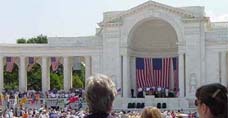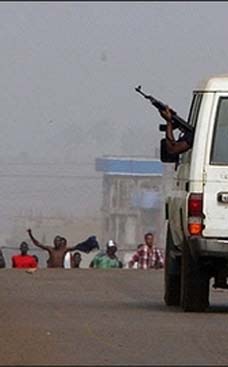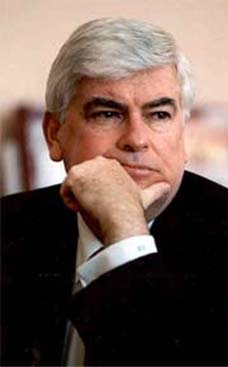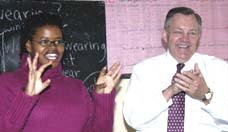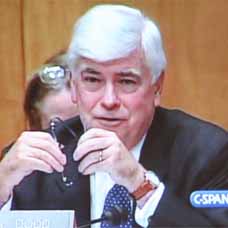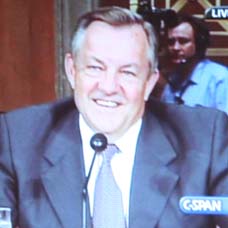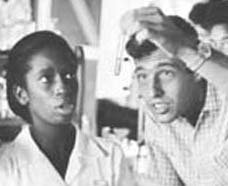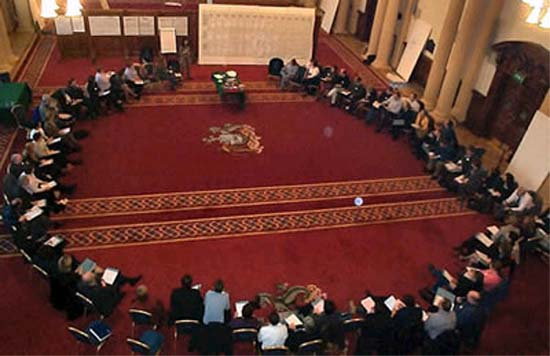
I was fascinated about the geometry of communication and it is very clear for me that the fundamental form for communication is the circle. If you invite people to sit in a circle they will communicate; in part they canít escape each other and in part because circles have no beginning and no end. There is no top there is no bottom, there is no hierarchy and everybody faces everybody quite equally.
RPCV Harrison Owen is the initiator of "Open Space Technologies"
OPENING SPACE - EXPANDING NOW
Caption: Open Space at Belfast City Council Staff Satisfaction Conference
Harrison Owen, the originator of Open Space Technology has been in Berlin in November 1998. OPENING SPACE - EXPANDING NOW was the title of an Open Space Training for about 100 people from all over Europe who are working as consultants and trainers. The training was organized by Michael Pannwitz. More about Harrison Owen and Open Space can be found here.
Location:
We met in a old church in the Johannes Kirche in Berlin Lichterfelde-West which with its circular layout is very well suited for gatherings. While "Open Space" was going on I met with Harrison Owen in the cafe in the church for an interview.
Interview:
Farah: Harrison, you are the initiator of "Open Space Technologies"; I have just seen how you opened an "Open Space" for more than 100 people. They are now above us in the church having fun together. Could you tell us something how you came to the idea bringing people together in this form of an "Open Space" and something about the main characteristics of "Open Space Technologies"?
Harrison.: Sure, I came to it because I was frustrated and bored and it was very simple: I had organized an international meeting for about 250 people and it took me a whole year of my life. I was an independent consultant, so I was not being paid. So we had this meeting, it was wonderful and when it was all over everybody said that they loved the meeting but what they really liked were the coffee breaks. Well I said to myself: "I am dumb but not stupid, so there really has to be a better way to organize a meeting. I had agreed to convene the same meeting two years later but I told my colleges that I will be happy to do it but I was not going to spend a whole year on it and if they chose somebody else, it would be alright but if they want me to do it I would do it in a different way and they should trust me. Strangely enough they did and four or five month before the next gathering I was wondering if I would find the fundamental mechanism for organizing a successful conference. I remembered an experience I had in West Africa where I lived for several years in some bush villages, where everything of importance happens in a circle. It seems to be always magic, Africa is using drums......
So I thought this would be good thing to start, but sitting in a circle is interesting but not terribly productive so we must use something where the people put down what they will talk about, so we need a kind of a bulletin board. Then people have to arrange when and where there could meet so we need a kind of market place, I was with my second martiny and so the idea was borne. So invite people to sit in a circle, create a bulletin board and a market place and it works.
*
F.: This principle of a circle you can find also in other cultures Ė for instance in the traditions of the native Americans. Could you say something more about this principle of a circle. Maybe the circle is a fundamental form how people could come together and maybe it is something we are not used to, because we are used to live more in a hierarchical system?
H:. Well I donít know, if somebody has made a study of this but I was fascinated about the geometry of communication and it is very clear for me that the fundamental form for communication is the circle. If you invite people to sit in a circle they will communicate; in part they canít escape each other and in part because circles have no beginning and no end. There is no top there is no bottom, there is no hierarchy and everybody faces everybody quite equally.
Interesting enough, if you put people in a sort of rectangle orientation as in sitting around a table they very quickly will look to one end or the other to find out where is the head of the table and they assume that there is my side and the other side. What you have done is to create the conditions for a negotiation and you will find that is what they start to do. If you place people in rows as we typically do in a standard meeting or in a classroom the only thing you will really gonna get is passive aggression, they hate you. There is nothing to do; it is a very clear power distribution. Who is in front is presumably smart and powerful and whoever is sitting in the chairs is presumably stupid and not powerful. You can either sit there and take notes or you can throw rocks at the person who is up there. But the idea of really communicating in any sense of interchanges just won't happen.
The shapes that we assume really become very important preconditions for communication. There are times when you want to negotiate to sit at a table or rectangable table. There are times when somebody does have some information and he is an expert in an area to sit in a classroom is quite appropriate and there are times where you need to share the information or develop new information and new ways of doing things and as far as I am concerned anything except the circle doesnít work.
*
F.: I could imagine many people would say, we could come together in a circle with ten may be with 30 people but if there are more people, it will not work. Have you any experience if there is a limitation for coming together in a circle?
H.: Yes, there are, but the limitations are less restrictive than you might think. With open space the smallest group I have ever worked with were 5 and the largest about over 750 people but I have colleges who worked with groups of more than 1000. We start always in a circle, but when we have 1000 people we sheat a little bit and do some concentric circles. It is still a circle and you still have the impression that you face all the people maybe except the two or three sitting just in front or behind your head. So there really isn't any limitation.
I have a college in Paris Christopher Shock he did an "Open Space" for Bosch (electrical company) for 1100 or 1200 people. The interesting thing is the dynamic of working with five or some hundred or more than thousand people are the same it all works exactly the same way.
We have in addition to the sort of the every day face to face reality we also have an electronic reality and when you put those two things together "Open Space" has a physical activity that takes place in a building with what ever number of people and link them by computer
It is possibly to work with 5000 people in hunks of 500 each and they could all be in the same city or they could be in Paris, Stockholm, New York, San Francisco or whatever and the electronic communication works. We don't use video conferencing or anything like that, just basically text computer stuff. This very quickly develops what I can only call a sort of an electronic consciousness. I really don't have the words for it but there is an exquisite sense of all of the participants. In theory there is no limit to the number of people we have.
*
F.: It is very surprising that such a thing as "Open Space" is functioning. Many people will wonder how could that work, there is no agenda, no plan. You just trust to something like self organizations; is there any kind of philosophy behind the idea of "Open Space" like in the Buddhism the idea that the Emptiness is the form and Form is the Emptiness?
H.: A lot of people will say "Open Space" is counterintuitive. I would disagree with that. It is absolutely intuitive, just our rational expectation is screwed up. We all know that, if you take 500 total strangers and bring them together around a common course with no prior agenda and no or just one facilitator everybody expects a total disaster. We had "Open Space" experiences around all over the world, thousands of instances, with all sorts of people from very senior executives to villagers in a tribal setting and to everything in-between. The common experience is that in less then an hour they will know what they will talk about; they will establish the working relationship to do that and they will be self-managing that. They will carry that process along to completion by themselves. There is the need for only one facilitator and that facilitator never intervenes in any part of the discussions and there is no problem. Even in very conflicting situations like we had in South Afrika, with Zulus and Haussas the self organization process works.
It raises an interesting question, what you did: "Why does it work when we all know it shouldnít?" - I think the answer is probably several fold, but - key to understanding why it works is pretty much what we are learning about the phenomena of self-organization. We now know that about chaos theory that in the midst of random disorder there is a pattern
We are coming to see Ė for a long time it was very esoteric science - that the distinction we have made between order and disorder as if we have two very clearly separated things just doesnít hold. In any moment of apparent order there is equally opening towards disorder or chaos and likewise what we might call chaos there is a tendency towards order or patterning.
Furthermore that in that kind of open dynamic environment, if you have just three or four or five very simple preconditions the process of ordering just takes place automatically. One of the major explorers in this area is an American by the name of Steward Kaufman who wrote a book called "At Home in the Universe". Steward actually is a theoretical biologist but what he has discovered over the years is that: given the following four or five preconditions order instantaniously happens, if there is a save protected environment. It is not out there in the middle of everything.
If there is a high level of diversity amongst the elements that might come together, if there is a great potential for complexity in terms of their possible inner relationships, if there is some sense of a movement towards improvement ... its a kind of hard because Steward works with molecules. I am not trying to say that molecules have intention but if two molecules come together to become a complex molecule, I suppose that is better.
The real critical one is that the whole thing be at the edge of chaos, it is a disturbed system it is not just sitting like a lam.
Steward experiences tell him - and I would believe him from what I have seen - that given those one or two others very simple preconditions order simply emergence at very complex levels - including human beings or whatever.
My sense is that the principles that Stuart and indeed a whole mass of other people who are working in this area are beginning to identifying and announce are: "Every bit as fundamental to existence in the world or being in the world as gravity, everything from a simple atom to complex human society is affected by these and in fact works from these. I don't care if you are an atom or a molecule or a human being - if I can pick you up and let you go you will fall because gravity is there and it is really that automatic.
So anyhow- Stewards notion - I pick him up but there are many others - given those very simple preconditions order will occur - as a matter of facts he talks about "Order for free"
I think that is exactly what happens in "Open Space". For years trying to explain when you should use "Open space" - years before I have read Stewards work Ė I used to say: Use "Open Space" in any situation characterized by high levels of complexity in terms of the issues, high level of diversity in terms of the necessary participants, the potential presence of real conflict where there is a need for decision yesterday. Well, it isn't quite one to one with the preconditions, but I think you haven't had to work to much too get there.
The self organization that takes place in an "Open Space" environment which is neither more or less what you would espect from any element of the creative order if the preconditions were present. I suppose the one thing we actively do in convening an "Open Space" is really to establish those preconditions, it is relatively safe, we invite anybody who cares which is by definition complex and random etc.
*
F.: The last years more and more people are using "Open Space Technologies". Could it be that this method is just appropiate in our times, because our whole world is now in a more chaotic situation.
H.: I think that is true - at some level. But I would say: "Open Space" had always been, there had never been a time when we didnít operate that way. We just pretended that we were organizing things.
In organizational theory people talk about formal organization , that was structured out and designed and there is an informal organization. For a long time people try to get rid of the informal organization because it was uncontrollable. We didn't want informal communication, we want formal communication. We didnít want the people to talk to anybody, we wanted them stick into channels. I don't think that this is very useful, but that's my opinion.
The informal organization is in fact the self organizing system and even those who would most decidually deny the presence and possibility of "Open Space" and that kind of things working have implicitly acknowledged its presence in operation.
Then you get to the interesting question of: "Which system Ė the formal or the informal organization actually gets things done?"
That really depends on whom you are asking and where you are asking them. If you are asking a senior executive: "Does this formal organization work?", for reasons of ego - I think- he says: "Of course it does, this is the way we do business!".
If you ask anybody else how something actually gets done, nobody ever bothers with the formal organization and indeed they know, that if they do, nothing will happen, it will just take for ever and nothing will happen. The way you get something done around here is, that you call up Herbert or Susi, may be you go and have a beer or may be do this or that. That's the way things get done. I will say first: "ĎOpen SpaceĎ has been for ever".
I do not say that all formal organization is bad but I am beginning seriously of thinking that it is unnecessary.
If Stuard Kaufman is right that "order is for free" or in other words: "The process of self organization does take place - not just as a theoretical possibility but as an everyday reality, which is what we experience in "Open Space". I do not care what time you are doing it or with what kind of group you are doing it. If the preconditions are made, it works.
If that is true, then unfortunately it says that the vast majority of time and effort we spent in organizing things itís fundamentally waste of time. If we would simply be careful about the preconditions, allowing it to occur and then may be help at once itís clear whatís organized and how itís doing it, then I think we spend a lot of time and effort.
The interesting question is: "Why we just notice this now", the second part of your question. I think it is as you suggested. All of a sudden it is becoming clearer that the way we have tried to organize our lives wheather that's a business, a country, a church or what ever are increasingly becoming simply unworkable. It is not that they are bad but most of the systems we have designed were actual designed and for times or in a time that moved much more slowly than our time.
50 or 100 years ago an event would occur and it might take a year to get the news and another year to make a response. We have organizations that work very comfortably in a two-year-time-frame. We now have a world which moves with nanoseconds. We just stress out when we try to run in that pace. So I think maybe whatís happening is: we are now just sensitive to being forced to be opened to some very different forces in our lives which have always been there. So it is more about remembering something than to create something new.
*
F.: When you speak about formal and informal organization I think also that our normal society is more organized by men and often the informal society is more organized by women as caring for the child and other more reproductive things. Yesterday when you were explaining the process of "Open Space" you were using a lot of symbols like the uterus of a woman and the giving of birth to explain the process of "Open Space". The circle and the more dimensional form of a circle as the spiral is often used as a symbol for the matriarchial society. We know that the spiral form gives order to the disorder, that's means it is a symbol for self-organisation,or we can say that the dynamic of the spiral stops the process of entrophy. Could one also say that women could easier facilitate an "Open Space"?
H.: It is a historical fact that women seem to find it easier to operate an "Open Space". There are more women - by factor three or four - working as facilitator in an "Open Space" than men. But I really donít think that it is gender specific - there is a nice ying and yang.
What is fun with "Open Space" you really can enjoy the femal energy and the male energy and you don't have to apologetic about either.
For example in the beginning of the ritual in "Open Space" and it is of course a ritual to walk around the circle which is a very feminine motion. It is really describing and opening up the womb and it is less a circle than a sphere. The next act is very much to walk to the center of the circle to say: "hear the plans to solve the problems of the planet". I noticed over time that my hand motions and my body motions are moving out of female energy to male energy. When I start walking around the circle, my hands are spread wide in a kind of openness and in moving to the center of the circle I find that my hands are pointing in a more decisive male attitude.
What is interesting, when you watch a woman facilitating an "Open Space", she will do the same things but being a woman, she will do it obviously in different ways. At some level it is a very interesting opportunity to explore male and female energy regardless of what sex you happen to be. It is an understanding that human systems simply do not function without a balance of male and female energy.
*
F.: You mentioned yesterday that you are also working as a consultant for big corporations. How could they accept this method of "Open Space Technologies"? Isnít this counteracting the hierarcal structure of a corporation?
H.: Actually I work with all sorts of people. I work with major organization, with government agencies, with townships, with association of advocats for breast cancer and neighboring schools. So I worked with many different organizations but you asked for corporations.
The answer is: "Yes, they accept this." Now the question is "why"? "Do all of them accept it?" "No!". One of the critical things in an "Open Space" environment is to understand that you are not in charge of it. Nobody is in charge of it. In fact it is an phenomena of self-organization, what means that everybody is in charge of it. So if you have a corporate environment where only the managing director or the president or whatever can have any ideas and has to be in control at all points of it, "Open Space" is not something to be comfortable with.
But there are two things to get their intention; one is when they are desperate. I think you could be desperate for two reasons, a terrible reason or a good reason. You can be desperate because suddenly you are going bankrupt or you can be desperate because you suddenly have this marvelous new idea and only two weeks to bring it to market and if you are going to miss the window of opportunity the competition is running off with your idea.
In those cicumstances people literally do not know what to do and I will often say to people:
"Never use "Open Space" if you know what to do!" When you figured out what is to do, then just do it. When you have run out of options, come and talk to me or read a book and do it yourself. I think initially there were things like that, there is an additional reason why people use "Open Space", it works just efficient. For example, I had the privilege of being with a design team on a 200 000 million Dollar project. They knew it will gonna take them 10 month. We did it in 2 days. When you can effectively do ten month work in two days - if you are in the business of making money that's called competitive advantage; if you are in the business of providing service - letís say social service- that's greater service for your clients or whatever.
My sense is, that the people understand they have less and less time to do what needs to be done, which is more and more and more. It becomes very clear that continuing to do what we have always done in the way we have always done it, it just doesn't work. It is not wrong or bad, it just doesn't work. If there is no alternative we run crazy and kill ourselves, and a lot of us are doing that. We have all these phenomena like stress, burning-out syndrom, soul pollution etc. It is totally unnecessary, I don't think we have to go through the hoops.
I find myself increasingly the last couples of years talking to particular corporations: "You can maintain the illusion of control or you can make money! You must chose! There is absolutely nothing in the world I know of which is less efficient than a centrally controlled hierarchically organized system. It is stupid.
*
F.: Do you think that it is possibly to manipulate people in using "Open Space Technologies". Let us say a corporation is inviting you just to show the people: "Well we do something for everybody!", but they are not interested in real participation.
H.: It is always possible, but in a very interesting way "Open Space" is self-correcting. In a situation where somebody does what you just said, at the very least what will happen is everybody will become totally frustrated and the situation will become worse, when the corporation only wants that the people feel good in "Open Space" and had absolutely no intention of doing anything about that. The next time when they feel badly they will be on strike, they have less opportunity to do anything.
One of the curious things that happens with "Open Space" in a corporate environment is, that very often the people who say: "We will maintain control" in fact than discover that they are suddenly in control. In an American corporation where we quite literally close the whole corporation down - it wasn't a huge one but a very well known one.
It was an "Open Space" for everybody - from the manager from the board to the man who actually swept the floor in the distribution center. The subject of focus was the future of the company. They had a great session, they came up with wonderful new ideas,
Six month after that "Open Space" I got a call from the president who actually brought me into the thing in the first place. Without explaining anything particually he told me: "I have just been fired." So I told him: "I am sorry!" I was curious but I didn't ask him why because I felt not to be in the place to ask him. Five minutes later the vice president for human resources called up and told me that they just fired a president. I said: "Yes, I know that." "May be you are even more interested in, why...? " I said: "Yes...!"
"Well you remember when we did this "Open Space" and everything was just great and we had all theses wonderful new ideas. Then it became clear that our president wanted to micromanage what was coming out of our process. He wanted to maintain control. Well, the first two month we tried to help him to understand, that that wasn't a very good idea - gently. The second two month we tried to explain him that that wasn't a good idea - more appointedly- and the last two month we worked for his resignation, which just occurred."
So this result was not what the president finally wanted but in terms for the life of the company it was absolutely what was required. But that is not unique, I have a number of experiences where large organizations went through an "Open Space" experience, where all people are happy except a few. The few are the ones, who suppose that they are in charge and they might say then: "Never again we will have an "Open Space!". In a curious way two, three, four, five years later and sometimes that long - we are back for organizing an "Open Space". It really takes on a life for its own. I often say to people: "There are bad and good news about "Open Space", the good news is "it works" and the bad news is "it works". In an "Open Space" people become enthusiastic, they will take charge, they feel ownership, they will feel pride and self-esteem, they get a lot done. If you really don't want this to happen, then don't do "Open Space".
*
F.: So would you describe the "Open Space" as a process to empower people to trust themselves?
H.: That is certainly the effect but I am a bit uneasy with the word "a method to empower".
It is more simple, it is simply a way of taking away some of the constraints, so that they recognize the power they already have. In fact in the final analysis: if I empower you, you are in my power; so it is really a process of self-discovering and not a question of whatever.
That becomes very clear in an "Open Space" environment. There is a facilitator, but you see the facilitator for 15 minutes in the beginning. Almost any other so called "large group in invention" you will have a facilitator who is working with the people all the way long.
Personally when I start an "Open Space" it takes 15 minutes in terms of what I have to say and another 25 to 30 minutes for the participants to find out what they want to do. At that point there isn't anything to do for me on an observable level.
So I typically go off and take a nap. That's very different from that kind of process we are familiar with, where the facilitator spend 8 hours in front of the audience and normally at the end of the day he is exhausted. I had a good nap.
*
F.: Like now, we are sitting here after you have started the "Open Space" doing the interview and hopefully there will be a good "Open Space".
H.: Hopefully they have some fun. Besides the fact I like to have a nap there are some practically reasons for doing this.
Right at the moment when the group starts, it is not only that they don't need my help, my presence is actually a hinderance, because then they will come up to me and asked me what to do or whatever and I will be totally unhelpful. I don't want to be nasty. The sooner they understand that the only person in charge is them, individually and collectively the better they are. So if I am not there they cannot ask me.
*
F.: There are some rules the facilitator give to the group. How to learn to become a facilitator of an "Open Space"?
H.: There are two answers to that, one is, it is very simple. You already know the rules and you have already done it. Before you start the interview you have told me that you are doing something very much like "Open Space" and you didn't have the name. Well, I think everybody does. So itís not rocket science doing "Open Space". It is not a complicated thing as you probably have recognized. I have literally seen people watching an "Open Space" and then they did it. But I wrote a book "Open Space Technologies" Use this guide; it is just what it says. The vast majority of the people around the world who do "Open Space", have read this book and then done it. Actually I think that that is the place to start. In part there are some more things in it, there are much more questions. What to do afterwards? That we are doing in the training program, but in terms of actually facilitating an event, there are two things good head and a good heart and the rest of caring well for yourself.
*
F.: In some article you spoke about the meaning of the meaning of the "Now" and the spirit.
H.: "NOW" for me is a kind of an image what "Open Space" is all about. You can make it sophisticated and complicated as you want or very simple, I like it more simple, so what is the NOW, the past is over, the future hasn't happen yet.
A lot of people have - how I call it - skinny NOWS, very thin NOWS; the problem with a skinny NOW is, that there is never enough time, typically people get very stressed and so forth. Then there are other sorts of people who have very big NOWS; it seems there is always enough time for everything, even if there is a lot to do, they seem to be so relaxed.
My experience in "Open Space" is: we grow NOW, there is really enough time and space to get things done. The story I told you about the Design team they did in two days what they thought will gonna take 10 month, that's a pretty big NOW.
At the very simplest level it is almost a funny idea, but obviously the notion of NOW is very part of any esoteric tradition I know; which brings up to me a very interesting connecting between "Open Space" and the whole realm of the spirit.
You open a space and spirit shows up; that's automatic, you can think of it as team spirit what you see with a football team or you can think of it as cosmic consciousness or whatever. I don't really care how I think about it. But however you think about it, it seems if you open up an "Open Space", there are very remarkable results.
People talk without really thinking about it as "Open Space" gatherings being inspiring, well inspiration quite literally means to inspirit. It is there, it is not that you bring the spirit to it, it is more that you acknowledge the presence of spirit and take away some of the barriers.
I don't want to make "Open Space" by any manners to some esoteric New Age cult, but I think frankly we can learn an awful lot about what seems to be a very simple set up procedures which have major impacts in an organization, what it does. How people could be involved, we can learn an awful lot about what is going on there in looking in two directions, one is what I was talking about before, a lot of the work that's coming out around chaos theory, complexity theory and self-organization and the other fruitful area to look is what we as human beings have discovered about the esoteric realms, because it doesnít take you terrible long, if you have been working with "Open Space" to understand that somehow rather quickly there evolves with the group. Something I would call collective consciousness, it is not group thinking , it is that the group very quickly seems to get beyond - behind its discrete brotherly-ness and starts to flow in some very powerful - unintentionally - kind of ways. In typically western thinking we think that we don't have the words or the concepts to talk about that reality. It may be one of the most striking phenomena that all of a sudden apparently strangers will quite quickly come to positive actions with no leadership forcing it and mostly in a real sense of joy.
*
F.: Probably you have heard of the physisist David Bohm who wrote the book about implicit and explicit order. In his later years he was experiencing with dialogue groups because he was convinced that people could solve the severe problems of this world when they really start to dialgue with each other. He made very clear that a real free dialogue is not the kind of discussion we are used to, where people are fighting for their arguments. In his free dialogue groups often more than 50 people came together trying to listen to each other and to speak freely about whatever comes up in that moment. Bohm reported that after a while there was a kind of atmosphere where the logos comes through, which is the meaning of the greek work "dialogos". In those moments one person could become the medium for the logos or you could say for the whole group.
H.: That's certainly "Open Space" experience, and of course out of Bohmís work comes the dialogue as a matter of research. I found out that one of the most interested things about "Open Space" gatherings is that dialogue is a sort of - formally considered - intense listening, this seems to be the coin of the realm, that is what happens. I suppose a whole mass of other behaviors, if you will, we may spend a lot of time training the people to do, self-managed work teams, real leadership, things like that. These seem to be automatic occurencies in "Open Space" environment, I don't think itís any tribute to "Open Space". I find myself thinking more and more that self-organizing systems natural function as dialogue and human self-organizing system naturally function in a dialogue mode. They manifest leadership as necessary, they experience themselves as one community. In a curious kind of way, stuff whether it is community building, team building, dialogue teaching, empowerment or leadership development and all those sorts of things - they seem to happen in an "Open Space" environment with no prior training, without even mentioning the word.
Those ideal states, that we hope for, are natural phenomena which occur if one allows for the central preconditions of self-organization, they simply occur. And I guess I would add learning to that code-word for complex system in the thought of Steward Kaufman and the others of the institute - they call it a complex adaptive system - so adaptive is learning , that is what learning all is about. It suggests that a naturally occurring self-organizing system is a learning system and then I guess I almost an organization by definition is a learning system, its not a question of inventing a system and bringing something new in, it is rather more a question of acknowledging, what already exists.
F: Harrison, thank you very much for this long and interesting interview!
